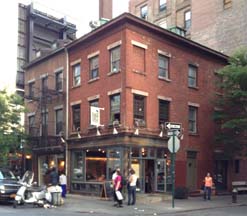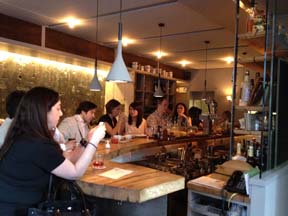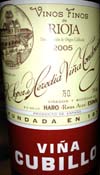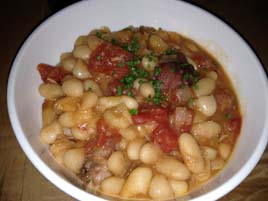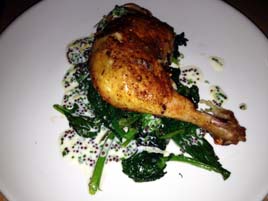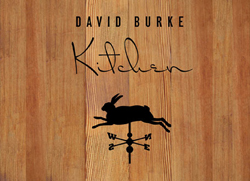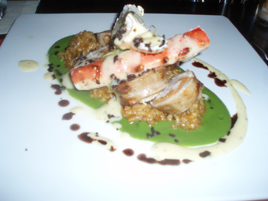Cómodo
 Monday, December 3, 2012 at 10:01PM
Monday, December 3, 2012 at 10:01PM  How can you not just smile and be pleased at the success of a restaurant like Cómodo?
How can you not just smile and be pleased at the success of a restaurant like Cómodo?
It grew out weekly dinners that the newlywed owners, Felipe Donnelly and Tamy Rofe, hosted in their TriBeCa apartment, starting in early 2010. Soon it was a full-fledged supper club called Worth Kitchen. By 2011 the health department caught on, and they had to close shop.
But a full-fledged restaurant was always the goal, and with a little help from Kickstarter, they finally have one—and in a lovely location, too, on the edge of Soho in the former Salt space. It’s a typical downtown dining room, with exposed brick walls, a bustling bar, and closely-spaced bare wood tables.
In a well-run restaurant, there are hundreds of things that just happen in the background, and the average diner never notices them until they’re not done right. At Cómodo, you never get the sense that the owners were amateurs a year ago. For a couple that was throwing once-a-week home dinner parties, Donnelly and Rofe have made the transition with remarkable ease.
The cuisine is Latin American, not exactly fancy, but a step up from comfort food. I gather it changes regularly. As of last week, there are seven appetizers ($10–17), six entrées ($17–28) and three desserts ($7–11).
I neglected to photograph the bread service, which came to the table warm, in a little paper bag, with soft butter that contained spackling of toasted almonds and sea salt. The overall effect was like a Ritz cracker.


A Brussels Sprout Caesar Salad ($10; above left), shaped like an over-size hockey puck, was the least successful dish we tried, as a garlic parmesan dressing obscured the flavor of the Brussels sprouts, and we didn’t detect much of a Caesar salad flavor either. (It looked better than the over-exposed photo shows.)
Roasted Cauliflower Gratin ($12; above right) was quite a bit more successful, sort of like a macaroni and cheese, with cauliflower replacing the macaroni.



Braised Berkshire Pork Shoulder ($24; above left) was excellent, and a much heartier portion than the photo suggests. It came with trumpet mushrooms, greens, and a huge helping of mashed potatoes (above center) with a surprisingly smoky flavor.
Duck Breast ($28; above right) was pretty good, but I hardly touched a wedge-shaped serving of quinoa sprinkled with butternut squash and smoked mozzarella. Next to the regal duck, it felt like a humble afterthought.


Flourless Chocolate Cake with passion fruit sauce ($11; above left) brought the meal to a strong conclusion, along with a small plate of petits fours (above right).
Aside from one minor glitch—really, not worth mentioning—service was better than you’d expect at such a casual spot. We didn’t sample the wine list, but they make a terrific Sangria. You won’t go wrong if you stick with that.
The restaurant was practically empty at 7:00 pm on a Wednesday evening, but by 8:00 it was nearly full. Aside from a Hungry City piece in The Times over a month ago, there hasn’t been much press coverage, so they must be getting good word-of-mouth. As of today, you can add me to the fanclub.
Cómodo (58 MacDougal Street between King & Houston Streets, Soho)
Food: Hearty, upscale Latin American cuisine
Service: Surprisingly polished
Ambance: A crowded, but not oppressively loud, downtown dining room
Rating: ★
Why? Food a shade below destination level, but in another year it might get there










